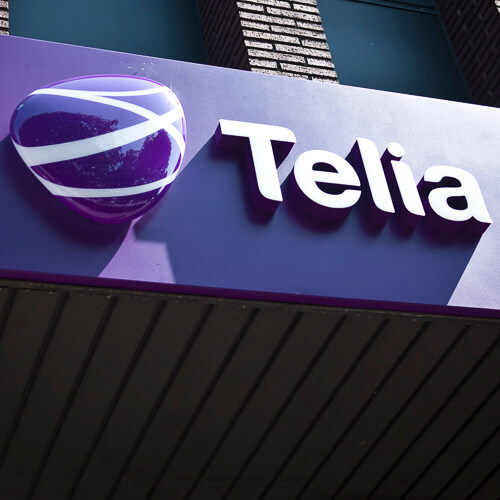Telia taps ServiceNow for on-prem service assurance
US software supplier can lay claim to a starring role in the Swedish telecom group's ambitious IT transformation program.

Sweden's Telia has announced a deepening of ties with US software company ServiceNow, which has emerged as a key player in the operator's quest to lower operational expenses.
Telia already uses workflows developed by ServiceNow to improve customer care, but now the Nordic telecoms group – which has operations in Sweden, Finland, Norway, Denmark, Lithuania, Latvia and Estonia – is tapping into the US supplier's expertise in service assurance.
"We've gone from a straightforward commercial agreement with ServiceNow to a strategic partnership," added Rainer Deutschmann, group COO at Telia, speaking to Light Reading.
Figure 1:  Shop talk: Expanding the relationship with ServiceNow is part of Telia's bid to cut operational costs.
Shop talk: Expanding the relationship with ServiceNow is part of Telia's bid to cut operational costs.
(Source: Håkan Dahlström on Flickr CC2.0)
It means Telia and ServiceNow are now working as partners on service assurance processes to increase levels of automation.
It represents another step forward for ServiceNow in the telecom space, although Telia is not what the US company calls a "design partner." Only BT and Deutsche Telekom currently have a design partner relationship with ServiceNow, which is in "e-bonding" and customer order management respectively.
"We've also released a new product called telecom service management, used by Telia, which takes the capabilities we have in customer care and extends it into the telecom-specific function," added Chris Bauschka, head of telecoms at ServiceNow.
"Telia, then, is upgrading its care experience to the telecom-specific care product we have as well."
Too many partners
Under a plan unveiled by Telia CEO Allison Kirkby in January, the aim is to trim operating costs across the group by 2 billion Swedish kronor (US$230 million) in the next couple of years and SEK4 billion ($460 million) by 2025.
A large chunk of savings – about SEK750 million ($86 million) – is expected to come from IT transformation.
ServiceNow appears to have been handed one of the starring roles to deliver on that target.
"We've had too many partners in the past," conceded Deutschmann, highlighting what he called a "brutal consolidation" of Telia's systems integration suppliers from 28 to four (Accenture, Capgemini, TCS and TietoEVRY).
Moreover, 75 legacy systems have been decommissioned this year with "hundreds more" in the firing line.
Just the ticket
Smarter handling of alarm tickets, which can sometimes arrive in "storms," is one of the ServiceNow attractions for Deutschmann. By integrating IT and network systems, and replacing manual processes with built-in automation, there is the promise of much better business outcomes.
"The new thing, and which is why we're working with ServiceNow in a strategic partnership to create a roadmap going forward, is to be able to correlate complaints – and this is the trick – from the customer side with alarms coming from the network side," said the COO.
"I can then backtrack and find the root cause of the problem."
Another promising service assurance feature from ServiceNow is filtering and aggregating high volumes of alarms in a smart way, so that the sought-after correlation can happen quickly.
"We proved to Telia that we could handle its peak volumes [of events]," said Bauschka.
Telia has already begun to consolidate its ticketing systems, but Deutschmann acknowledges that service assurance and orchestration – of which ticketing is just one part – will always be a work in progress.
Reflecting on work needed for IT transformation and digitalization, Deutschmann sees "constant change as the new norm," and that he expected partners to be continually pushing for improvements.
The prize of improving service is not just about greater cost-efficiencies gleaned from more automation, however.
Deutschmann sees the provisioning of enterprises with a single and "end-to-end" view of all their services and being able to do proactive customer care – fixing problems before they impact end-users – as a USP that can keep customers and attract new ones.
The first full implementation of ServiceNow is expected by December.
On-prem, not public cloud
Unusually for ServiceNow, which typically engages with partners using a public cloud SaaS model, Telia has gone for an on-premises deployment on a country-by-country basis.
"Our strategy is cloud first, but cloud first doesn't necessarily mean public cloud," said Deutschmann.
"If I can go to the public cloud I will, but if regulation precludes me from doing so I will go to my own clouds."
Due to a mixture of national autonomy regulation, security requirements and specific customer requirements in the countries in which Telia operates, said Deutschmann, ServiceNow instances are placed in the operator’s private cloud environment.
Want to know more OSS and BSS? Check out our dedicated OSS and BSS channel here on Light Reading.
By "copying and pasting" platforms without any deviation of code in each country, and using open ServiceNow APIs, Deutschmann nonetheless sees an upside to the on-prem model.
"You've got to be future ready and resilient, so it doesn't completely break down when there is a change in some certain regulation," he said, "and the private cloud gives that."
On-prem economics, argued Deutschmann, were not that far off the public cloud either. He added that there are "brilliant tools" available to keep the DevOps model up and running .
While Telia is currently not planning to run operations and maintenance (O&M) systems in the public cloud, Deutschmann said it was "ready to reconsider whenever the legal, security and business situation allows."
Related posts:
— Ken Wieland, contributing editor, special to Light Reading
Read more about:
EuropeAbout the Author(s)
You May Also Like












